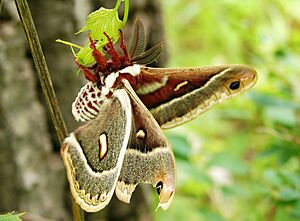Columbia silkmoth facts for kids
Quick facts for kids Columbia silkmoth |
|
|---|---|
 |
|
| Scientific classification | |
| Genus: |
Hyalophora
|
| Species: |
columbia
|
| Synonyms | |
|
|
The Columbia silkmoth, also known as the larch silkmoth, is a type of moth from the family Saturniidae. This family includes many large, colorful moths. The Columbia silkmoth was first described by Sidney Irving Smith in 1865.
This moth lives in many parts of North America. In the east, you can find it from Quebec and Ontario in Canada, down to Michigan, northern Wisconsin, and southeastern Manitoba. In the west, it lives from Alberta and Montana, stretching south through the Rocky Mountains all the way to southwestern Texas and into central Mexico.
What Does It Look Like?
The Columbia silkmoth is quite large. Its wingspan (the distance from one wingtip to the other) is usually between 80 and 100 millimeters. That's about 3 to 4 inches wide!
Adult moths are active for a short time each year. You can usually see them flying from May to July. There is only one generation of these moths born each year.
What Do They Eat?
The young moths, called larvae (or caterpillars), eat leaves from different plants depending on where they live.
Eastern Diet
In the eastern parts of their home range, Columbia silkmoth caterpillars mainly feed on the Larix laricina, which is also known as the tamarack or American larch tree.
They have also been seen eating other trees in western Ontario, such as:
- Prunus pensylvanica (pin cherry)
- Alnus rugosa (speckled alder)
- Betula papyrifera (paper birch)
Western Diet
In the western parts of their range, the caterpillars have a wider variety of plants they like to eat. These include:
- Prunus demissa (western chokecherry)
- Prunus emarginata (bitter cherry)
- Purshia tridentata (antelope bitterbrush)
- Rosa (wild roses)
- Salix (willow trees)
- Shepherdia argentea (silver buffaloberry)
- Eleagnus angustifolius (Russian olive)
- Ceanothus (wild lilac shrubs)
Subspecies
Sometimes, a species can have slightly different groups within it, called subspecies. These groups might look a bit different or live in different areas. The Columbia silkmoth has two main subspecies:
- Hyalophora columbia columbia
- Hyalophora columbia gloveri (found in the Rocky Mountains)
The Hyalophora columbia gloveri subspecies is sometimes even considered a separate species entirely, known as Hyalophora gloveri.


